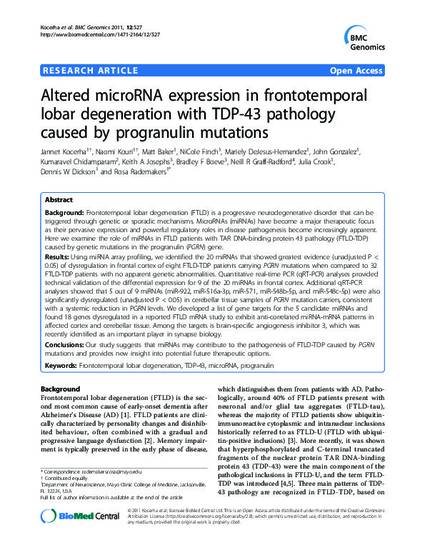
Frontotemporal lobar degeneration (FTLD) is a progressive neurodegenerative disorder that can be triggered through genetic or sporadic mechanisms. MicroRNAs (miRNAs) have become a major therapeutic focus as their pervasive expression and powerful regulatory roles in disease pathogenesis become increasingly apparent. Here we examine the role of miRNAs in FTLD patients with TAR DNA-binding protein 43 pathology (FTLD-TDP) caused by genetic mutations in the progranulin (PGRN) gene.
Results
Using miRNA array profiling, we identified the 20 miRNAs that showed greatest evidence (unadjusted P < 0.05) of dysregulation in frontal cortex of eight FTLD-TDP patients carrying PGRN mutations when compared to 32 FTLD-TDP patients with no apparent genetic abnormalities. Quantitative real-time PCR (qRT-PCR) analyses provided technical validation of the differential expression for 9 of the 20 miRNAs in frontal cortex. Additional qRT-PCR analyses showed that 5 out of 9 miRNAs (miR-922, miR-516a-3p, miR-571, miR-548b-5p, and miR-548c-5p) were also significantly dysregulated (unadjusted P < 0.05) in cerebellar tissue samples of PGRN mutation carriers, consistent with a systemic reduction in PGRN levels. We developed a list of gene targets for the 5 candidate miRNAs and found 18 genes dysregulated in a reported FTLD mRNA study to exhibit anti-correlated miRNA-mRNA patterns in affected cortex and cerebellar tissue. Among the targets is brain-specific angiogenesis inhibitor 3, which was recently identified as an important player in synapse biology.
Conclusions
Our study suggests that miRNAs may contribute to the pathogenesis of FTLD-TDP caused by PGRN mutations and provides new insight into potential future therapeutic options.
- Frontotemporal Lobar Degeneration,
- TDP-43,
- MicroRNA,
- Progranulin
doi:10.1186/1471-2164-12-527
source:http://www.biomedcentral.com/1471-2164/12/527
Available at: http://works.bepress.com/jannet_kocerha/8
